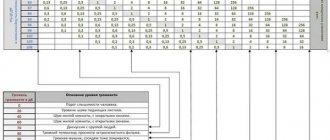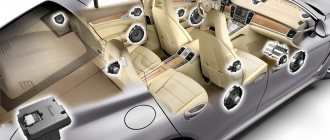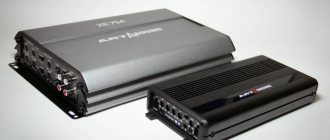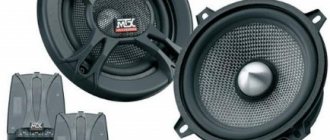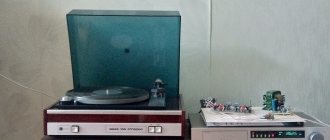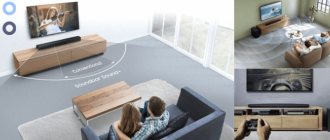Even if we assume that not all car owners are music lovers, the number of those who are not satisfied with the sound quality of a standard car radio is quite large.
Having realized the need to replace it with high-quality reproduction equipment, many are faced with a dilemma, which again comes down to the price/quality ratio. Simply put, they have a difficult choice between coaxial and component acoustics.
In search of the “right” choice, you can pore over specialized literature for months, study the principles of constructing such systems, and ultimately come to the conclusion that it would be easier to consider the advantages and disadvantages of each of the systems, their features and differences, and based on this make a final decision. This is exactly what we will do now.
Coaxial acoustics
So. The advantages of coaxial acoustics are ease of installation . Take the speaker, mount it in its standard place, connect it, and your speaker system is ready. Also, coaxial cables tend to be cheaper. And the main disadvantage, oddly enough, stems from the ease of installation and location of the speakers in one basket. Then you will understand why.
Most often, “coaxials” are used to add audio to the rear zone of a car, as well as in situations where physical separation of high-, mid- and low-frequency speakers is not necessary, or is simply impossible.
Common installation locations are rear doors or rear parcel shelf.
Acoustic power and sensitivity
Many people are interested in how to choose speakers for a car radio, but they do not understand what is meant by such a parameter as power. There is a misconception that the higher the power, the louder the speaker will play. However, in practice it turns out that a speaker with a power of 100 W will play quieter than a speaker with half the power. Thus, we can conclude that power is not an indicator of sound volume, but of the mechanical reliability of the system.
The volume of the speakers to some extent depends on their power, however, it is not directly related to this parameter. It makes sense to pay attention to the power of an audio system only in cases when it comes to purchasing acoustics for an amplifier. However, in this case, only the rated power (RMS) is important, since other numbers will not provide any useful information to the buyer and will only mislead him. But even RMS sometimes has little to do with reality, so it is fair to say that the power indicator is extremely uninformative for potential speakers buyers.
The size of speaker magnets is also deceptive because high-end audio systems use neodymium magnets. Despite the fact that they are quite unremarkable in appearance, their magnetic properties are slightly higher than those of ferrite magnets. In practice, this means that the sound of the former is much stronger. Due to their miniature size, neodymium magnetic systems also have a shallow seating depth, which simplifies their installation in a car.
Sensitivity is a parameter of audio systems that shows the intensity of sound pressure. The higher the sensitivity, the louder the sound, but only if the specified power is supplied to the speakers. For example, a low-power speaker paired with a powerful amplifier can produce louder sound than a high-sensitivity speaker. The unit for measuring sensitivity is decibel divided by the threshold of hearing (dB/W*m). Sensitivity is affected by parameters such as sound pressure, distance from the source, and signal strength. However, it is worth noting that you do not always need to rely on this parameter because some speaker manufacturers measure sensitivity under non-standard conditions. Ideally, sensitivity should be measured at a distance of no more than one meter when a signal of one watt is applied.
When choosing a speaker for your car, ask the seller what sensitivity this speaker has? Low sensitivity is 87-88 db; we recommend choosing acoustics that have a sensitivity of 90-93 db.
Also read the article “how to choose the right amplifier for your audio system.”
Component acoustics
Component acoustics consists of several speakers , there may be two of them, then this is a two-component system, or maybe three, in which case this is a three-component system. As a rule, such acoustics are installed at the front of the listener.
Speakers for a component system can be selected separately or purchased as a ready-made kit. It should be noted here that all components in the kit are balanced with each other. If you want to purchase speakers separately, you will need to take into account their frequency ranges and select a crossover .
A crossover is needed in order to divide the signal between different speakers and send high frequencies to tweeters or high-frequency speakers (HF), and middle frequencies to midbass or midrange.
One of the advantages of component acoustics is that they can be correctly positioned in the car. This complicates installation, but significantly improves the sound quality of the system.
Due to their characteristics, high-frequency speakers have a narrow directivity , that is, undistorted sound propagates close to the direction axis. Therefore, they need to be placed facing the listener, approximately at the height of the head (ears).
HF installation example
Then you get the highest quality and detailed high-frequency sound that these tweeters can provide. They are usually installed in the corners of the side mirrors or in the windshield pillars.
Example: HF in the corner of the mirror
In three-component acoustics, the midrange speaker (MF) has a sound propagation angle that is not much greater than that of the tweeter, so its directionality is also very important. They are installed according to the same rules, usually together with tweeters.
Example of setting midrange and treble
In midbass, the sound spreads much wider. Therefore, they are suitable for installation in a standard place in the door. True, to maximize the impact of good sound, they are slightly turned towards the listener, giving better directionality. This is exactly why podiums are made or door cards are remade.
Primary introductory
To begin with, it would be nice to understand that no matter what kind of speaker system you like, it will still be a layout diagram, which is not only a car radio and a pair of speakers, but also an amplifier, a changer, a subwoofer, a lot of wires and mounting devices (example in the next photo).
The difference between component and coaxial acoustics
Coaxial acoustics
The difference between coaxial and component acoustics
Judging by the increasing price factor, the first on this list is an ordinary wideband speaker.
Wideband speaker
Next on the list is a coaxial speaker for a car radio, whose advantage over a broadband speaker is its greater coverage of the audio frequency range. The design feature of the coaxial speaker system itself is as follows:
- There are several speakers in one housing;
- Reproduction of sound vibrations of various frequencies is divided into areas;
- To separate the electrical signal going from the “head” to the speaker, a special filter is used - a crossover* (in more “serious” models it is carried out in a separate housing, in more “simple” ones an ordinary capacitor is used as a filter).
A crossover is a “capacitor-inductor” circuit, the purpose of which is to separate certain values of the entire frequency spectrum along audio tracks. It is used in both component and coaxial speaker systems.
Crossover
Advice! Choosing the right filter components plays a huge role in the sound of the entire speaker system.
The main advantage of a coaxial acoustic system is that, without having a large sum of money on hand, it is quite possible to assemble a decent version of the acoustic layout circuit for yourself. And what’s more, installing this system will not cause any difficulties for the car owner; all installation and connection work can be done with your own hands in several stages:
- We install new equipment in its standard place (more expensive modifications, as a rule, are installed non-standardly, on a pedestal, etc.);
- We connect the speaker output directly to the radio itself or to a signal amplifier.
The disadvantages of the system described above include, despite the praise described above, the sound quality, which is somewhat away from the ideal parameters. The thing is that one speaker simply physically cannot clearly reproduce the entire spectrum of sound; frequency mixing is inevitable, which affects the sound quality.
Component acoustics
What is the difference between coaxial acoustics and component acoustics?
A component speaker system looks more favorable in terms of sound quality and undistorted frequencies, in which each speaker reproduces exactly its own frequency range and is connected to its own individual channel of the car radio/amplifier, due to which the entire acoustic circuit works harmoniously and its components do not interfere or interrupt each other.
However, as you know, you have to pay for everything:
- The price for this type of acoustics is much higher;
- High demands on the car radio itself (see Compare car radios and choose the best), the prices for which are also “biting” (having connected all the professional “stuffing” to an ordinary “head” you are unlikely to become a connoisseur of good sound);
- Difficulties of installation (it will be somewhat problematic to correctly distribute the frequencies and install the speakers in the car with your own hands, although who knows, it’s not gods who burn the pots, and there are plenty of video instructions on the Internet...);
- In most cases, it will not be possible to avoid the use of additional soundproofing materials in the car interior.
Results
Coaxial acoustics : ease of installation, relatively low price, but the sound quality is lower compared to component acoustics. It is better to use it for sound in the rear area of the car, if needed. Common installation locations are rear doors or rear parcel shelf.
Component : costs more, requires an installation approach. But the sound quality is much higher. Has ample customization options. Installed from the front of the listener.
Diffuser and suspension material
Any professional description of loudspeakers must contain information about the material from which they were made. The following materials can be used for the manufacture of diffusers: paper, polypropylene, bextren, titanium, magnesium, aluminum and so on.
The most common are paper diffusers. During their manufacturing process, sheets of paper are compressed, after which they are given a conical shape. But it is worth saying that, in fact, almost all paper diffusers can be classified as a composite type, since other synthetic materials are used in their production process. Famous manufacturers never disclose what materials are used, because each of them has its own proprietary recipe.
- The advantages of paper diffusers include detailed sound, which is created due to high-quality internal damping. The main disadvantage of paper diffusers is considered to be their low strength, as a result of which the sound power in the audio system is limited.
- Diffusers made of polypropylene have a more complex design. They have a neutral sound and excellent impulsive characteristics. At the same time, such diffusers are more resistant to mechanical and atmospheric influences than paper diffusers.
- Diffusers made of titanium and aluminum began to be made in Germany in the 80s. Their production is based on vacuum deposition technology. Domes made from these materials have the best sound quality: the sound is transparent and clear.
In conclusion on this section, I would like to say that manufacturers have learned to make good acoustics from almost any material; there are even speakers made of precious metals, but they cost a lot of money. We advise you to pay attention to speakers with a paper cone; they have a very decent sound and have been tested by more than one generation.
It is also necessary to pay attention to what material the outer suspension of the diffuser is made of. The suspension can be made of the same material as the diffuser, or it can also act as a separate element in the form of a ring made of rubber, polyurethane or other material. One of the highest quality and most common suspensions is rubber. It must maintain linearity over the range of motion of the loudspeaker system, and also have flexibility as this affects the resonance frequency.
A subwoofer is the same speaker that is capable of reproducing only low frequencies “What is the difference between a passive subwoofer and an active one.”
Focal Performance PS 165
Average cost - 17,500 rubles
The leader in the ranking is the Focal Performance PS 165 component system. This is a car audio system with a diameter of 16 cm (oversized). The model of the French manufacturer is considered one of the highest quality for a car.
The equipment produces crystal clear sound and has adjustable crossovers (a pair of high-frequency controls).
Features and characteristics: - size - 16 cm; — strips — 2 pcs; — power — 80 W (nominal) and 160 W (maximum); — frequency — 60-20,000 Hz. - including customizable external crossover; - speaker material - aluminum.
Professionals: - pleasant bass; - dense and clear sound; — crossovers can be customized; — convenient installation; - laconic design.
Disadvantages: - when the bass increases, noise appears, but this effect is rarely observed; short thread; — for maximum comfort of use, you will need to purchase an additional amplifier.
INTERESTING TOP 10 Best TV series about space
Differences between the two systems
- In component speakers, each speaker has its own unique frequency, and therefore operates autonomously, while in coaxial speakers, all frequencies are combined in one speaker
- The sound in coaxial devices is highly directional.
- The frequency filter (crossover) in component speakers is external and is represented by a separate device, while in coaxial speakers such a filter is most often built-in. Therefore, the sound and clarity are much better in the first case.
- Coaxial speakers cost much less.
- When installing a component system, there may be difficulties and certain conditions must be met.
In conclusion, I would like to note that when choosing one type of system, you should take into account your needs and goals that must be achieved. If you do not plan to use the speakers frequently, and the owner is not a music lover, then there is simply no point in spending money on expensive component systems. The sound quality and cost of coaxial speakers will suit many, but if music in a car plays a certain role in life, then it is better to spend money on a more expensive component system, which, if installed correctly, will give clear and beautiful sound.
Electronics and technologyComment
Ivolga VHC-6.21
Average cost - 4800 rubles
Acoustics of domestically produced components. It claims to be faithful to the sound and, according to consumers, is a leader in the quality of low-frequency reproduction.
When configured correctly, the sound will be bright and natural.
The system copes well with music of any genre. However, for beginners this may cause problems with installation - there are no instructions included in the kit.
Technical indicators: — size — 16 cm; — rated power — 70 W; — maximum power — 140 W; — frequency — 65 — 20,000 Hz. — external crossover; — tweeter magnet — neodymium, fabric diffuser; - woofer magnet - composite, paper diffuser; — additions: network protection, bass range adjustment, tweeter signal.
Professionals: - soft and high-quality bass; — the crossover has overheating protection; — possibility of installing tweeters at the desired angle.
Disadvantages: - small cross-section of speaker cables; - no instructions.
Tips for choosing car speakers
When choosing a speaker system for your car, follow a few tips:
- Understand the features of component and coaxial technology discussed above. Unfortunately, many car enthusiasts do not see the difference between these devices, considering them identical. But, as can be seen from the article, this is not so. When installing component acoustics, it is worth engaging professional craftsmen who can accurately install and configure the system.
- Don't focus on power. The mistake of many car enthusiasts is that when choosing, they focus only on the power of the speaker. This approach is wrong. Power displays the highest threshold at which devices produce sound of decent quality. Most often the parameter is 20-30 W.
- Pay attention to installation. If installation requires the manufacture of additional structures, then this should be taken into account. So, for the frontal system, installation in standard places is suitable. Make modifications if necessary. The maximum diameter of the speakers is 16 centimeters. Fulfilling this requirement simplifies the setup in relation to the subwoofer.
Pioneer TS-E130CI
Average cost - 6610 rubles
The system has 13 cm speakers, but this only affects the quality in the right direction - the bass comes with excellent sound.
INTERESTING Best Augmented Reality Glasses 2022: Snap, Vuzix, ODG, North and much more
When installing, there is a small recommendation: you should distribute the sound insulation over the doors so that the sound is as soft and deep as possible.
Characteristics: — size — 13 cm; — strips — 2 pcs; — rated power indicator — 35 W; — maximum power indicator — 180 W; — sensitivity — 88 dB; — crossover included.
Professionals: — the subwoofer sounds bright and clear; — no additional amplifier required; - low potential.
Disadvantages: - high price; - the speaker may not reproduce high frequencies clearly; — manual sound correction is required.
What is the difference between coaxial and component acoustics, which one should you choose?
Driving in a car without music turns into real torture. At the same time, each car enthusiast has individual requirements for sound quality. Some are satisfied with a light musical “background” in the background, while others need clear and spacious sound.
That is why, when choosing acoustics, the question becomes which option to give preference to - coaxial or component acoustics.
Alpine SPG-17CS
Average cost - 6200 rubles
The Alpine SPG-17CS is a good sound system without an amplifier, but at a good price.
Features a powerful speaker response.
The tweeter has a silk dome, and the magnetic drive is neodymium. The design is equipped with ventilation ducts for proper distribution of air flow. Overall, the system has smooth, high-quality sound.
Characteristics: — size — 16 cm; — strips — 2 pcs; — power — 70 W (nominal) and 280 W (maximum); — frequency — 68 — 20,000 Hz. — included — external crossover; - tweeter material - silk.
Professionals: - transparent sound; — high-quality assembly; - reasonable price; — Possibility of installing a choice of tweeters.
Disadvantages: - low frequencies sound good when tuning; — large equipment capacity with door installation only; - without an amplifier they do not produce high-quality bass.
Focal P 165 VT 20
Average price - 17,800 rubles
Finally, the “tastier” it is, like the icing on a cake, or rather, the more “sound”. The design of the P 165 VT 20 is the result of collaboration between Focal and the national brand Chernov Audio. All its characteristics meet high standards.
The acoustic drivers have a special dust-resistant coating and a profile that improves midrange frequencies even when the radiation is rejected.
The speakers are tonally balanced, delivering an open and clear mid-range and high-frequency extension.
Characteristics: — size — 16 cm; — strips — 2 pcs; — rated power — 70 W; — maximum power — 140 W; — sensitivity — 93 dB; — frequency range — 60 — 28000 Hz; — the tweeter has a neodymium magnet; - aluminum woofer.
Professionals: - beautiful effects at any volume; — good sensitivity; - high-quality sound.
Disadvantages: — the speaker housing is made of plastic; - high price.
TOP 10 audio systems
We bring to your attention a list of the best, in our opinion, speaker systems. Note that “best” does not mean “loudest”, since too loud sound can damage your hearing. It is also contrary to established noise regulations. Some of the systems presented are available as standard in some car models, while others must be purchased separately.
Bose Media System
(available in Ferrari 612 Scaglietti)
It is believed that in sports cars, engine noise drowns out the sound of the acoustics. However, the system we are considering cannot be silenced. It is distinguished by exceptionally high-quality sound, which it provides in the cabin.
Bose Media System in a Ferrari
Boston Acoustics
(available in Chrysler 300C)
This 368-watt speaker system delivers great sound in all driving conditions. It is equipped with 7 speakers that have special filters. For full sound, it is equipped with a subwoofer.
Boston Acoustics - great audio system
Rockford Fostage
(available in Mitsubishi Lancer Evolution)
The speaker power is 650 watts. The system is equipped with nine speakers and a 10-inch subwoofer (located in the trunk). It is distinguished by its ability to skillfully process sound. This acoustics is sensitive to changes in speed and can equalize the volume of sound.
Sound system Rockford Fosgate
THX 2
(available in Lincoln MKX)
Very clean audio system. Treats bass in the same way as other sound ranges. Equipped with 14 speakers and has a power of 600 watts.
High-quality audio system for Lincoln car
Dynaudio
(available in Volvo S80)
The audio system uses settings from the famous Danish company Dynaudio. Equipped with 12 speakers. Each of them has its own filter, which makes the sound extremely clear. Acoustic power - 650 watts.
Dynaudio - famous acoustics
Bose 5.1 Cabin
(available in Cadillac CTS)
The speakers are equipped with ten speakers. They provide precise fullness of sound. The sound quality does not change, regardless of the speed of the car.
Bose 5.1 Cabin - sound system installed in the Cadillac CTS
Harman
(available in Mercedes - CL class)
Not everyone can afford a Mercedes car. But you can try to purchase the acoustic system that is installed on such models. It provides surround digital sound. Thanks to precise tuning, 600 watts of power is provided. The system consists of fourteen speakers.
Mercedes car interior with Harman acoustics
Bowers & Wilkins
(available in Jaguar XF)
Acoustic power is about 440 watts. Surround sound from the speakers is provided by 13 speakers and a powerful subwoofer. The product quality is considered very high.
Jaguar XF audio system
Mark Levinson Refrence
(available in Lexus LS)
The system power is 450 watts. Sound distortion rate is less than 0.1%. With a range of 20-20,000 hertz, you won't miss a sound. The system is equipped with a hard drive (8 gigabytes).
Interior of Lexus LS and its acoustics
Thinking out loud, comparison
Unfortunately, at the moment there is no manufacturing company that would produce ideal component speaker systems; each has its own advantages and disadvantages. And if we assume that the car radio spends most of its working time broadcasting, then a reasonable question arises about the advisability of such high material costs. The ordinary wideband speakers already installed by the automaker will be sufficient, since no acoustic system will be able to qualitatively reveal the deep bass and high frequencies of your favorite radio station. The main difference between coaxial acoustics and component ones is that the coaxial one plays from one point, while the component one plays from the same point as its speakers. As for the playback range, in both cases it is divided into several parts, but in both cases the “high-frequency speakers” do not interfere with the propagation of low-frequency waves. In principle, the speakers in both cases should be as close to each other as possible, this condition is especially true for “high-frequency speakers” connected in a three-way system. Speaker systems differ in the number of connected speakers and sound reproduction formats (implemented by combining several acoustic systems):
- Two-way includes LF/MF (midbass) and MF (tweeter) speakers;
- Three-way - adds another midrange speaker.
The number of bands is determined by the crossover - the number of bands is equal to the number of input speakers:
- Stereo format (2-channel) – a pair of front wideband speaker systems;
- Dolby Surround, surround sound (4-channel) – a pair of front + a pair of rear systems;
- Presence effect, 5.1, Dolby Digital (6-channel) - a pair of front + a pair of rear + central system, as well as a subwoofer.
In addition, it is necessary to take into account the physical size of the speakers, since the sound quality of speakers operating in the low and mid-frequency regions greatly depends on the size of the case (acoustic design). For example:
- To reproduce “deep” bass, it is recommended to install 16-17 cm speakers (but even with such “pancakes” you will not be able to keep up with the most ordinary subwoofer, which is simply irreplaceable at low frequencies);
- The speaker sizes of 10, 13 and 16 centimeters are designed for a volume equivalent to a car door, which involves their installation in the door body (there are exceptions, you need to look individually at the installation recommendations, which can sometimes simply be printed on the packaging box);
- Due to its small size, the high-frequency speaker should not be treated with disdain; it plays a very important role in the entire acoustic layout.
Ground Zero GZTC 165TX
Average cost - 6300 rubles
The Ground Zero GZTC 165TX acoustics are suitable for motorists who love loud and clear sound.
The highest rating is based not only on technical characteristics, but also on German build quality.
The sound from the speakers is especially bright.
Main indicators: — size — 16 cm; — rated power — 110 W; — maximum power — 160 W; — frequency — 50 — 20,000 Hz. — the kit includes an external crossover; — tweeter magnet — neodymium, silk diffuser; - woofer magnet - nerrite, paper diffuser.
Professionals: - nice design; — detailed and smooth frequencies; - good sound effects.
Disadvantages: - plastic container; — the speakers are difficult to make out.
Brand
Another recommendation that can be given to those who are thinking about choosing a specific manufacturer is not to chase a low price and be careful when purchasing speakers from unknown manufacturers. No matter how tempting the sellers’ words may be, you should not pay attention to these tempting offers, since it is always better to turn to manufacturers that have long proven themselves in the market.
They have decades of experience in speaker manufacturing, value their reputation, and therefore produce only high-quality products. The answer to the question of how to choose acoustics for a car is no longer as simple today as, for example, ten years ago, because there are a large number of manufacturers on the market (more than 200). The dominance of Chinese speaker systems significantly complicated the task. You should not completely neglect Chinese products, because if you are on a tight budget, buying a speaker system from China will not be such a bad decision. But the problem is that there are a large number of unscrupulous sellers on the market who present audio systems made in China as a branded product from American or European manufacturers. In this case, the buyer who decided to spend a couple of hundred rubles will buy “branded” acoustics for $100, when its real price does not exceed $30.
If we consider this criterion as a specific sound, then for a more natural sound it is recommended to buy European audio systems (Morel, Magnat, Focal, Hertz, LightningAudio, JBL, DLS, BostonAcoustic, this is not the whole list). We also recommend that you refrain from purchasing such companies as (Mystery, supra, Fusion, Sound max, calcel). These manufacturers have a very ridiculous price, but the sound quality of these speakers is appropriate. Speaker systems from Sony, Pioneer, Panasonic, JVS, Kenwood are also very good options, but some of their owners complain about average sound quality. If you are looking for the ideal combination of parameters such as price and quality, then it is best to contact the manufacturers listed above.

